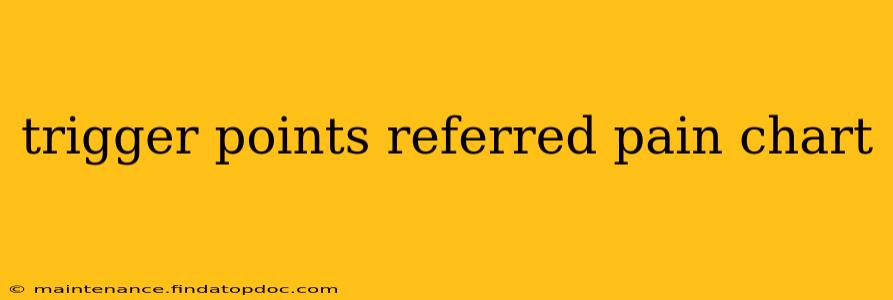Myofascial pain, characterized by persistent muscle pain and tenderness, often stems from trigger points – hyperirritable spots within a muscle. These trigger points can cause referred pain, meaning the pain is felt in an area distant from the actual trigger point location. Understanding a trigger point referred pain chart can be invaluable in identifying the source of your pain and seeking appropriate treatment. This guide will explore the complexities of referred pain patterns and offer insights into common trigger points and their associated pain referral zones.
What is a Trigger Point Referred Pain Chart?
A trigger point referred pain chart is a visual representation illustrating the potential areas where pain may radiate from specific muscle trigger points. These charts aren't perfectly precise – individual pain patterns can vary based on factors like individual anatomy, the severity of the trigger point, and other contributing factors. However, they serve as a helpful guide for both healthcare professionals and individuals seeking to understand their own pain. Think of it as a roadmap, providing general directions, but not necessarily a precise GPS location for every instance of referred pain.
Common Trigger Points and Their Referred Pain Patterns
Several muscles are prone to developing trigger points, resulting in characteristic pain patterns. While a comprehensive chart would be extensive, let's examine some key examples:
Trapezius Muscle:
- Trigger Point Location: Upper, middle, and lower trapezius muscles in the upper back and neck.
- Referred Pain: Pain can radiate to the neck, shoulder, upper arm, and even the head, often manifesting as headaches. The location of the trigger point heavily influences the referral pattern. An upper trapezius trigger point may cause pain primarily in the neck and head, whereas a lower trapezius trigger point may refer pain more to the shoulder blade and upper arm.
Levator Scapulae Muscle:
- Trigger Point Location: Located in the neck, near the base of the skull.
- Referred Pain: Pain typically radiates to the upper trapezius area, the top of the shoulder, and sometimes into the medial aspect of the scapula (shoulder blade). It can also cause headaches, especially around the temple region.
Pectoralis Major Muscle:
- Trigger Point Location: Chest muscle.
- Referred Pain: Pain can spread to the anterior (front) chest wall, often down the inner aspect of the arm and sometimes into the forearm and hand.
Latissimus Dorsi Muscle:
- Trigger Point Location: Large muscle in the lower back.
- Referred Pain: Pain often radiates to the lower back, the outer aspect of the arm, and into the hand.
How Accurate Are Trigger Point Referred Pain Charts?
While trigger point charts provide a valuable framework for understanding referred pain, it's crucial to remember they are not foolproof. Several factors can influence the specific pain pattern experienced:
- Individual Anatomy: Variations in muscle structure and nerve pathways can influence pain referral patterns.
- Trigger Point Severity: The intensity of the trigger point will impact the area and intensity of referred pain.
- Coexisting Conditions: Other medical conditions might complicate the pain presentation, making it difficult to solely attribute pain to trigger points.
- Nervous System Sensitivity: An individual's nervous system sensitivity can affect how pain is perceived and referred.
What to Do if You Suspect Trigger Point Pain?
If you suspect you are experiencing pain from trigger points, consulting a healthcare professional is crucial. They can perform a thorough physical examination, rule out other potential causes, and guide you towards appropriate treatment options. Treatment may include:
- Manual Therapy: Techniques such as massage, stretching, and trigger point release.
- Dry Needling: A specialized technique using thin needles to deactivate trigger points.
- Physical Therapy: Exercises to improve muscle strength, flexibility, and posture.
Frequently Asked Questions (FAQs):
Are trigger point referred pain charts reliable? Trigger point charts are useful tools, but they offer generalized pain patterns. Actual pain referral can vary based on individual factors.
Can trigger points cause headaches? Yes, trigger points in muscles of the neck, such as the trapezius and levator scapulae, are commonly associated with headaches.
How can I find a reliable trigger point referred pain chart? Consult reputable medical websites or textbooks on musculoskeletal medicine. Always discuss findings with a healthcare professional.
What is the difference between myofascial pain and referred pain? Myofascial pain is pain originating from muscle tissue, and referred pain is pain felt in a location distant from the source due to nerve pathways. Trigger points are a common cause of both myofascial and referred pain.
Remember, this information is for educational purposes only and should not be considered medical advice. Always consult with a healthcare professional for diagnosis and treatment of any pain condition. A proper medical evaluation is crucial for accurate diagnosis and effective management of your pain.
